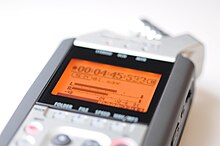
Back Digitální záznam Czech Цифрăлла сасăçырав CV Grabación digital de sonido Spanish ضبط دیجیتال Persian Taifeadadh digiteach Irish Perekaman digital ID Registrazione digitale Italian 電気録音 Japanese Gravação digital Portuguese Înregistrare digitală Romanian
This article needs additional citations for verification. (June 2009) |

In digital recording, an audio or video signal is converted into a stream of discrete numbers representing the changes over time in air pressure for audio, or chroma and luminance values for video. This number stream is saved to a storage device. To play back a digital recording, the numbers are retrieved and converted back into their original analog audio or video forms so that they can be heard or seen.
In a properly matched analog-to-digital converter (ADC) and digital-to-analog converter (DAC) pair, the analog signal is accurately reconstructed, within the constraints of the Nyquist–Shannon sampling theorem, which dictates the sampling rate and quantization error dependent on the audio or video bit depth. Because the signal is stored digitally, assuming proper error detection and correction, the recording is not degraded by copying, storage or interference.
© MMXXIII Rich X Search. We shall prevail. All rights reserved. Rich X Search